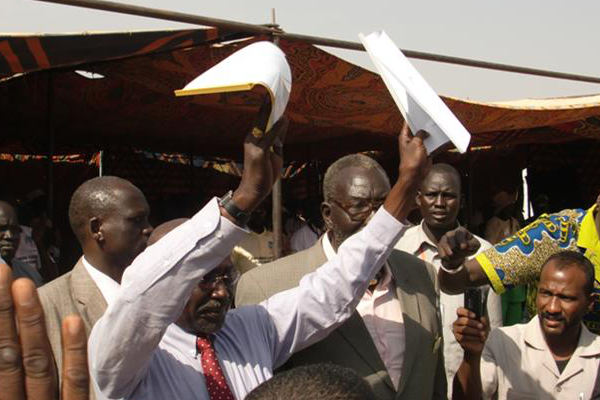
Grassroots Conference Opens Doors for Peace in Southern Sudan
Note: The region of Southern Sudan referenced here is now the Republic of South Sudan, since gaining independence in 2011. BRIDGE activities such as these provided valuable support to communities as they made the transition to independence.
For decades, the disputed and oil-rich border regions between Northern and Southern Sudan have witnessed scenes of violence as disputes over water and access to grazing land erupt into brutal tribal conflicts. Though the Comprehensive Peace Agreement, signed in 2005, officially put an end to fighting between the Government of Sudan and the Sudan People’s Liberation Movement, regional clashes continued — driven largely by a scarcity of water for cattle herds and compounded by lack of state authority to mediate between the two sides.
But early in 2010, leaders from the Dinka Malual of Northern Bahr el Ghazal and the Rezeigat of South Darfur came together to lay out a joint plan to end the violence. Senior leaders from the two tribes met in Aweil on Jan. 22-25 that year for a grassroots peace conference aimed at fostering dialogue and reconciliation. The governors of Northern Bahr el Ghazal and South Darfur jointly organized the conference with USAID facilitation to provide a forum for mediation between the two groups, with the hope of reducing tension and increasing cross-border cooperation.
Aware of the organizational challenges involved in such a gathering, Governor Paul Malong of Northern Bahr el Ghazal contacted Winrock International’s USAID-funded BRIDGE (Building Responsibility for Delivery of Government Services) program and outlined areas of logistic and financial support necessary to make the conference a success. For BRIDGE, it was a unique opportunity to support a Sudanese-led initiative that not only yielded peace dividends, but also demonstrated a new capacity on the part of local government to be responsive to citizens’ needs. USAID’s Office of Transition Initiatives, Pact Sudan and other donors also contributed to the conference preparation.
By late January, representatives from both tribes began to arrive in Aweil. Dinka and Rezeigat members shared traditional songs and dances between formal discussions and negotiations. At the end, the 175 conference participants issued a joint communiqué outlining the major community security priorities and asked for greater international assistance to achieve these goals. The communiqué called for better management of seasonal grazing routes, the creation of a jointly administered traditional court to resolve disputes, and a prohibition against either community carrying small arms onto the other’s territory.
This spring, the state director of resolutions, an elected official from Northern Bahr el Ghazal, confirmed that his state’s government and the Rezeigat of South Darfur adopted the resolutions from the conference. The success is a victory not only for the Dinka Malual and Rezeigat, who have a new opportunity for peaceful coexistence and cooperation, but for other tribes for whom this experience may serve as an example. It has showcased the capacity of local government leaders to mediate and resolve disputes, directly responding to the needs and concerns of their constituents.
